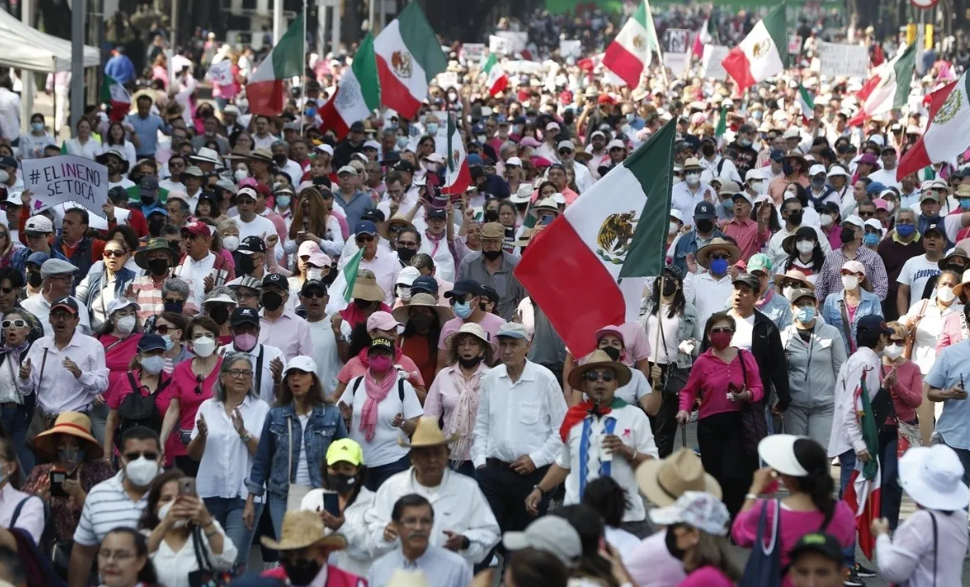
by Luis Hernández Navarro
The anti-Obrador day of November 13 was the largest mass mobilization convened by an opposition front of the current six-year term. Under the pretext of defending the National Electoral Institute (INE) and democracy, a motley coalition of anti-AMLO center-right forces managed to bring out to the streets several tens of thousands of citizens, many dressed in white and pink, almost all over the country.
Its magnitude was far from reaching the size of the popular rallies called by the President. Undoubtedly, it will also be smaller than the one that the President’s supporters will hold this December 1st. But, even so, it would be very delicate to disregard the meaning and scope of last Sunday’s protest.
The streets are not the primary terrain of struggle of the center-right. They have other means of pressure. John Lennon, composer of Working Class Hero, knew this well when, in 1963, at The Beatles’ show before Queen Elizabeth II, he quipped: “For our last number, I’d like to ask for your help. Could the people in the cheapest seats clap? And the rest of you, just rattle your jewels.”
A protest against López Obrador the size of this Sunday’s gathering is something that hasn’t happened since June 27, 2004. On that date, the business and media right wing, under the façade of the fight against public insecurity, orchestrated a great mass onslaught against the then head of the Mexico City Government, which served as a rehearsal to prepare his impeachment. The offensive was orchestrated through the electronic media, repeatedly broadcasting images of violence, which generated a feeling of uncertainty and fear in the public opinion of the country’s capital. Hundreds of thousands of people, many dressed in white, marched to rescue Mexico.
Among other differences present in both mobilizations is that, unlike the one in 2004, the one on Sunday was not promoted by the electronic media, but by a very important part of the written press and the social networks associated with right-wing public intellectuals. Probably, the way in which the President recriminated the call to defend the INE and referred to some of its promoters was what catalyzed the protest.
In analyzing the day of November 13, it is important to distinguish between the organizers and those who attended the marches en masse. They are not the same. The organizing core is formed by the alliance of openly backward businessmen, opposition parties, religious hierarchs and an archipelago of intellectuals (the transitologists) with enormous weight in the INE and the organization of electoral processes. The demonstrators were a diverse conglomerate of affluent sectors, rabidly anti-communist groups, middle classes and popular clienteles of the Mexico City municipalities in the hands of the opposition, dissatisfied with the federal government for different reasons.
Entire families participated enthusiastically in the “pink tide,” many for the first time in their lives. In the human river that walked unorganized in contingents along Paseo de la Reforma in Mexico City, there were people of all ages unaccustomed to chanting slogans.
Like a fraudster version of the Rocky Horror Picture Show, the march was attended by a collection of embarrassing partisan egos, who paraded energetically, and who in other circumstances would hardly have coexisted under the umbrella of the same event. In the streets, their presence faded before a crowd that ignored and overflowed them, but they were rescued from anonymity by the press. As if his biography embodied the history of INE, the figure of the morning was José Woldenberg. A unique speaker, he served as the rising star of a right-wing opposition without strong political figures, and with washed-up intellectuals. It remains to be seen if the anti-Obrador coalition will continue to placate him.
Beyond the presence of consummate electoral fraudsters disguised as ordinary citizens, such as Ulises Ruiz, Elba Esther Gordillo or Roberto Madrazo, the protests confirmed the increasingly waning support for the 4T among middle sectors, anticipated in the mid-term elections of 2021. In those elections, the opposition won half of the mayors’ offices in Mexico City (the jewel in the Obrador crown) and many of the state capitals in dispute. Despite winning the elections, the ruling coalition lost the qualified majority in the Chamber of Deputies and had 9 million fewer votes than in 2018.
The mobilizations were a receptacle for part of the uneasiness towards the 4T among university students, liberal professionals, doctors, housewives, artists, human rights defenders, feminists, relatives of victims of violence, scientists, environmentalists and small businessmen. Many are not conservatives. Quite a few supported the President in the past. But they no longer do so. They are disenchanted and even angry. The extent of their dissatisfaction led them to join the call of figures such as the disgraceful Claudio X. Gonzalez, the most rancid of the parties, ultra-right-wingers who came out of the closet, and prominent electoral tricksters, hidden under the mask of INE’s defense.
Beyond the outcome of the electoral reform promoted by the President, Sunday’s “pink tide” was, for the right-wing opposition, not a citizens’ day, but the starting gun for their electoral campaign for 2024. It remains to be seen if they can keep the momentum and mass support they had.
This article was published in La Jornada on November 15th, 2022. https://www.jornada.com.mx/2022/11/15/opinion/018a2pol English translation by Schools for Chiapas.
